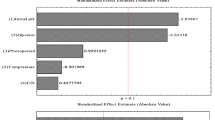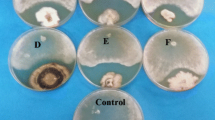Abstract
A study was conducted to determine the feasibility of using sclerotia ofSclerotinia sclerotiorum for producing conidia ofConiothyrium minitans in liquid culture. The medium (SST) was made of water containing 2.0, 1.5, 1.0 or 0.5% (w/v) ground sclerotia ofS. sclerotiorum and 100 µgl −1 thiamine hydrochloride (HCl). One ml of conidial suspension (2 × 107 conidia ml−1) ofC. minitans LRC 2534 was inoculated into 100 ml of SST medium or control (thiamine HCl in water) and incubated at 20 ± 2°C on a shaker at 200 rpm. Subsamples were removed periodically and examined under a compound microscope. Conidia in the SST media germinated within 24 h, developed into branched hyphae within 48 h, produced pycnidia after 3–4 days, and the pycnidia released mature conidia after 7 days. Production of conidia varied with the concentration of sclerotia in the SST medium. It was lower (3.6 × 106 conidia ml−1) at 0.5% but higher (1.2 × 108 conidia ml−1) at 2%. The new conidia were viable and the colonies developing from them showed the original morphological characteristics. It was concluded that using SST liquid medium as a substrate for mass production of conidia ofC. minitans has potential for use in commercial development of this mycoparasite as a biocontrol product.
Similar content being viewed by others
References
Anon. (2000) US Approval Applications. Agrow, January 21. 344:19.
Bardin, S.D. and Huang, H.C. (2001) Research on biology and control of Sclerotinia diseases in Canada.Can. J. Plant Pathol. 23:88–98.
Boland, G.J. and Hall, R. (1994) Index of plant hosts ofSclerotinia sclerotiorum.Can. J. Plant Pathol. 16:93–108.
CAB International. (2005) Crop Protection Compendium. Wallingford, UK. (www.cabicompendium.org/cpc).
Campbell, W.A. (1947) A new species ofConiothyrium parasitic on sclerotia.Mycologia 39:190–195.
Cheng, J.S., Jiang, D.H., Yi, X.H., Fu, Y.P., Li, G.Q. and Whipps, J.M. (2003) Production, survival and efficacy ofConiothyrium minitans conidia produced in shaken liquid culture.FEMS Microbiol. Lett. 227:127–131.
de Vrie, T., Antoine, T., Buitelaar, R.M., Bruckner, S., Dissevelt, M., Durand, A.et al. (2001) The fungal biocontrol agentConiothyrium minitans: Production by solid-state fermentation, application and marketing.Appl. Microbiol. Biotechnol. 56:58–68.
Gugel, R.K. and Morrall, R.A.A. (1986) Inoculum-disease relationships in Sclerotinia stem rot of rapeseed in Saskatchewan.Can. J. Plant Pathol. 8:89–96.
Huang, H.C. (1977) Importance ofConiothyrium minitans in survival of sclerotia ofSclerotinia sclerotiorum in wilted sunflower.Can. J. Bot. 55:289–295.
Huang, H.C. (1978)Gliocladium catenulatum: Hyperparasite ofSclerotinia sclerotiorum andFusarium species.Can. J. Bot. 56:2243–2246.
Huang, H.C. (1980) Control of sclerotinia wilt of sunflower by hyperparasites.Can. J. Plant Pathol. 2:26–32.
Huang, H.C., Bremer, E., Hynes, R.K. and Erickson, R.S. (2000) Foliar application of fungal biocontrol agents for the control of white mold of dry bean caused bySclerotinia sclerotiorum.Biol. Control 18:270–276.
Huang, H.C. and Erickson, R.S. (2000) Soil treatment with fungal agents for control of apothecia ofSclerotinia sclerotiorum in bean and pea crops.Plant Pathol. Bull. 9:53–58.
Huang, H.C. and Erickson, R.S. (2004) Effect of soil treatment of fungal agents on control of apothecia ofSclerotinia sclerotiorum in canola and safflower fields.Plant Pathol. Bull. 13:1–6.
Huang, H.C. and Kokko, E.G. (1987) Ultrastructure of hyperparasitism ofConiothyrium minitans on sclerotia ofSclerotinia sclerotiorum.Can. J. Bot. 65:2483–2489.
Huang, H.C. and Kokko, E.G. (1988) Penetration of hyphae ofSclerotinia sclerotiorum byConiothyrium minitans without the formation of appressoria.J. Phytopathol. (Phytopathol. Z.) 123:133–139.
McLaren, D.L., Huang, H.C., Kozub, G.C. and Rimmer, S.R. (1994) Biological control of sclerotinia wilt of sunflower byTalaromyces flavus andConiothyrium minitans.Plant Dis. 78:231–235.
McLaren, D.L., Huang, H.C. and Rimmer, S.R. (1986) Hyperparasitism ofSclerotinia sclerotiorum byTalaromyces flavus.Can. J. Plant Pathol. 8:43–48.
McLaren, D.L., Huang, H.C. and Rimmer, S.R. (1996) Control of apothecial production ofSclerotinia sclerotiorum byConiothyrium minitans andTalaromyces flavus.Plant Dis. 80:1373–1378.
McQuilken, M.P., Budge, S.P. and Whipps, J.M. (1997) Production, survival and evaluation of liquid culture-produced inocula ofConiothyrium minitans againstSclerotinia sclerotiorum.Biocontrol Sci. Technol. 7:23–36.
McQuilken, M.P., Gemmell, J. and Whipps, J.M. (2002) Some nutritional factors affecting production of biomass and antifungal metabolites ofConiothyrium minitans.Biocontrol Sci. Technol. 12:443–454.
Purdy, L.H. (1979)Sclerotinia sclerotiorum: History, diseases and symptomatology, host range, geographic distribution, and impact.Phytopathology 69:875–880.
SAS Institute. (1999) Statistical Analysis Software, Version 8.2. SAS Institute, Cary, NC, USA.
Steadman, J.R. (1983) White mold — A serious yield-limiting disease of bean.Plant Dis. 67:346–350.
Zadoks, J.C. (1993) Antipodes on crop protection in sustainable agriculture.in: Corey, S., Dall, D. and Milne, W. [Eds.] Pest Control and Sustainable Agriculture. CSIRO, Canberra, Australia. pp. 3–12.
Author information
Authors and Affiliations
Corresponding author
Additional information
http:www.phytoparasitica.org posting Jan. 23, 2007.
Rights and permissions
About this article
Cite this article
Huang, HC., Erickson, R.S. Use of sclerotia ofSclerotinia sclerotiorum for efficient production of conidia ofConiothyrium minitans in liquid culture. Phytoparasitica 35, 140–145 (2007). https://doi.org/10.1007/BF02981108
Received:
Accepted:
Issue Date:
DOI: https://doi.org/10.1007/BF02981108




